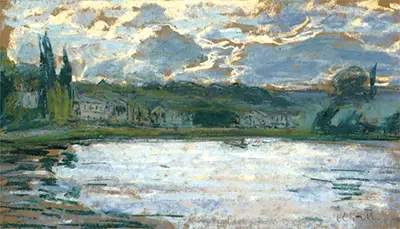Painted in the first decade of his artistic career and at a time when he was feeling disheartened with his apparent lack of recognition, Monet was on the brink of becoming recognised for his skill in impressionism and countryside depiction.
The focal point for Bank of the Seine is Camille. She sits idly on the bank of the river idly gazing across to the inn on the opposite side of the seine in the town of Bonnières-sur-Seine. Just in front of her, a rowing boat sits on the water's edge. It is presumed to be the boat in which the couple have rowed over.
Though the viewer cannot see her expression, she is perhaps full of worry as the Monet and herself had recently been blessed with a child, though had very little fortune to their name. The baby, a boy called Jean, was said to feature in early additions of the painting and was held closely by Camille.
It is not known why the child does not appear in the final version. Monet was said to have produced more than one piece of work during this short vacation, though it is only this piece that has survived. It was to be soon that the family were forced to leave the inn after they could no longer afford the expense.
On the Bank of the Seine begins to reveals some of the trademark features of impressionism, in which Monet became a leader of the field. The location is open countryside, not too far from Paris. Indeed, the area was recommended to Monet by the novelist Èmile Zola as somewhere cheap but that still offered open country landscape whilst remaining easy to access from the city. Similar art was produced by Cezanne, Renoir and Degas.
The landscape offers the opportunity for the Monet to explore different presentation of textures, from the smooth clear water to the ruffles of the dress that Camille wears. The colours, too, are in keeping with the times: a careful blend of blues, greens and yellows.
All of this enables the artists to play with the light and depth of the painting and provide the viewer with a multi dimensional scene.
Of particular note is Monet's clever use of diagnols, from the top left to bottom right, the picture opens up from dark to light, a closed view obscured by the tree to the openness of the opposite side of the river.
Monet takes the viewer on a clever journey, revealing the view carefully, allowing the viewer to be drawn away from Camille and explore and enjoy the world around her.
This oil on canvas piece of art can still be enjoyed at the Art Institute of Chicago.


